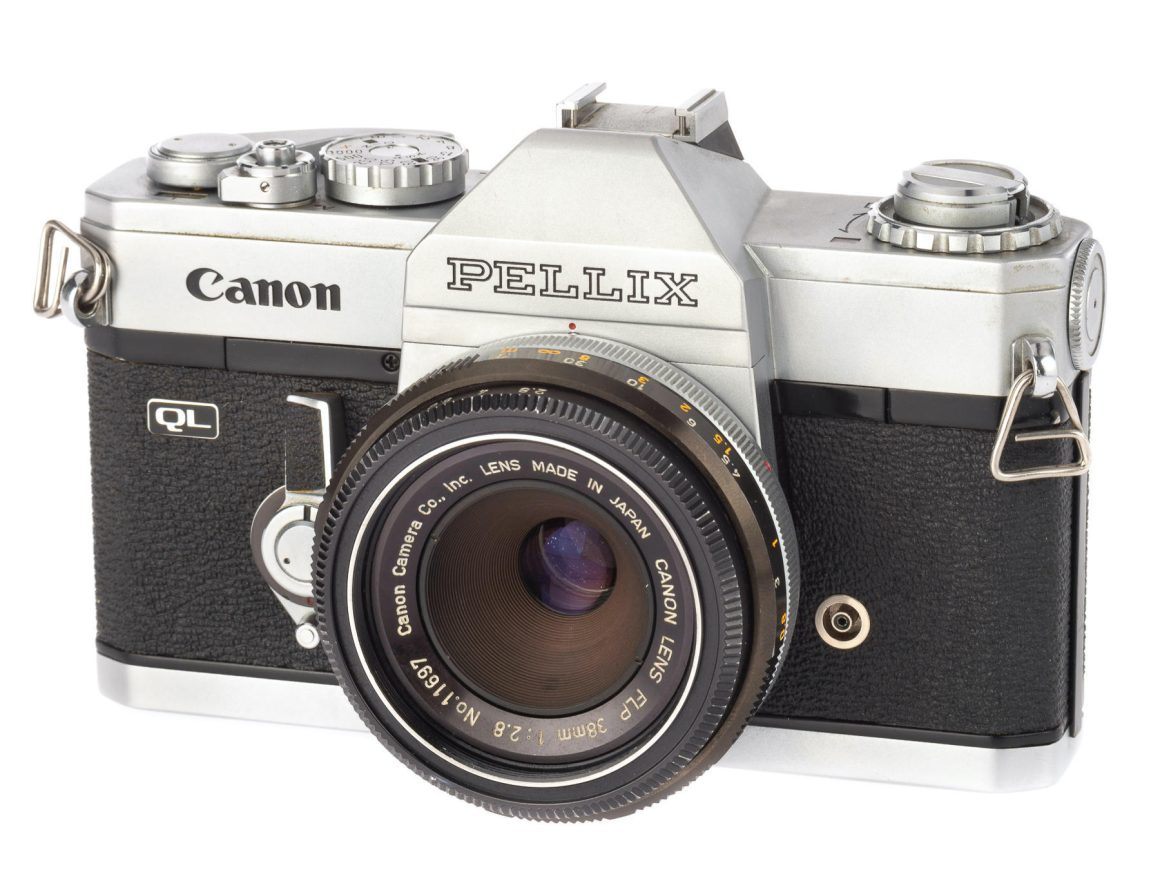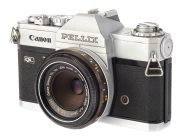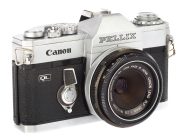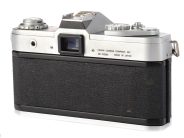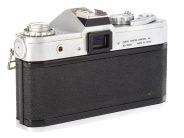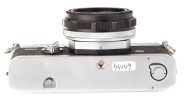Canon PELLIX QL
35mm MF film SLR camera
Specification
| Production details: | |
| Announced: | March 1966 |
| System: | ● Canon FL (1964) |
| Format: | |
| Maximum format: | 35mm full frame |
| Film type: | 135 cartridge-loaded film |
| Mount and Flange focal distance: | Canon FL [42mm] |
| Shutter: | |
| Type: | Focal-plane |
| Model: | Mechanical |
| Speeds: | 1 - 1/1000 + B |
| Exposure: | |
| Exposure metering: | Through-the-lens (TTL), stop-down |
| Exposure modes: | Manual |
| Physical characteristics: | |
| Weight: | 755g |
| Dimensions: | 144x91x43mm |
Manufacturer description #1
An improved PELLIX marketed at the same time as the FT QL. Film loading was easier, the Canon Booster for low-light metering could be attached, and the stop-down lever had a locking mechanism.
The newly designed FL 50mm f/1.4 II lens was highly rated for its high resolving power, excellent contrast, and color balance. This lens served as the standard for the later line of FD lenses.
Manufacturer description #2
The CANON PELLIX QL takes photography one step forward. It is Canon's newest and most advanced Single Lens Reflex camera and a triumph of engineering and design.
The new PELLIX QL offers you CANON's latest discoveries: the revolutionary fixed pellicle mirror used in conjunction with CANON's Through-The-Lens-and-Mirror (TTLM) system of photography.
Now, as an exciting addition, CANON makes dim-light photography a reality with an atatchable CANON BOOSTER. This vital accessory boosts the power of the CdS meter to track down even the faintest light in dim surroundings. CANON's BOOSTER heightens the sensitivity of this extraordinary new camera.
The PELLIX QL also features CANON's lightning-quick method of changing film - Quick Loading. QL mechanism frees you of threading, fussing or fumbling with film.
The new PELLIX QL brings photography to an impressive new level. One you will want to explore to the fullest.
Dim Light Worries a Thing of the Past
Poor lighting conditions no longer mean poor pictures thanks to CANON's new BOOSTER. This excellent accessory acts as a powerful aid to the CdS photocell in registering the faintest trace of light in dim surroundings. By attaching the BOOSTER, you can get precise readings in almost total darkness. Recent tests have proved the effectiveness of this combination of CdS photo-cell plus BOOSTER. Pictures taken at night under the most adverse lighting conditions proved to be as sharp and clear as daytime shots under the best possible conditions.
What's more, the versatile CANON PELLIX QL with BOOSTER can take film speeds from ASA 25 to an unbelievable ASA 12,800. The light-measuring range of the PELLIX QL is increased from a low of EV-4.5, f/1.2 30 seconds to EV 18 with ASA 100 film compared to a low of EV 2 in competitive SLR cameras.
This means that you can explore such specialized fields as macrophotography, oscillography, and microphotography. And do this without using any mathematical compensation.
Exposure Readings Most Precise with TTLM System
With TTLM, the CdS photocell is positioned in front of the film plane hence there is no deviation between the exposure reading and the exposure itself. It "sees" only the original light. This accuracy is not possible with cameras where the CdS photocells are located near the eyepiece. The revolutionary CANON Through-The-Lens-and-Mirror system makes it impossible for unwanted light to reach the exposure meter. This does away with inaccuracy common to systems with independent windows.
TTLM does this by using a stationary pellicle mirror — the first of its kind in the world. This fixed mirror, a micro-thin "film", acts as a beam splitter sending light to both the viewfinder and the CdS meter in front of the film plane at the same time. Because of this unique system there is no image blackout with the PELLIX QL — even when long exposures are necessary. The fixed pellicle mirror, incorporated into CANON's TTLM system, opens new vistas to the exploring cameraman.
Spot Selection Sheds New Light on Your Subject
The Spot Selection System is far superior to meters employing the averaging method in competitive SLR cameras. Measuring light by the averaging method (averaging the bright light and shadow) does not always result in a sharp, clear exposure. CANON has improved on this system by allowing you to spot measure the center of interest. You can take a light reading at the same time as you focus on the subject.
The CdS meter takes a specific light reading (covering one-ninth of the total picture area) which is clearly outlined by the rectangle in the viewfinder. Whether you use a wide angle tens or the longest focal lens, the "one-ninth" portion of the exposure-sensing area never changes.
With the CANON PELLIX QL, averaging is also possible. Just read the shadows and highlights. Then average.
QL Makes Loading Easier than Ever
CANON's new Quick Loading mechanism allows you to change your film in seconds. And now the CANON PELLIX QL has it.
Only three easy steps for you to follow in loading:
- Open the back of the camera.
- Place the film leader onto the specially designed take-up mechanism.
- Close the back of the camera. Your camera is now loaded and ready for use.
CANON's Quick Loading mechanism takes any standard 35mm film cartridge, whether color or black and white. And with this system, there is no waste film or delays in loading.
25 Interchangeable Lenses for PELLIX QL
The PELLIX QL takes a wide range of interchangeable lenses. To cover every aspect of photography Canon has 25 lenses for use this new camera. Among them are such extra-special lenses as: 19mm F3.5R, a super wide-angle lens which can be mounted on the camera without lifting and locking the mirror. Macro FL 50mm F3.5, which has extra-high resolving power for macrophotography. FL 55mm-135mm F3.5 and FL 85mm-300mm F5, both high performance zoom lenses with automatic pre-set aperture diaphragms designed especially for Canon owners.
Also Canon offers a great many attachments including Bellows FL, Extension Tube FL, Slide Duplicator to name a few. The BOOSTER is an accessory item with the CANON PELLIX QL. It is an important attachment that will greatly heighten the sensitivity of the camera.
Manufacturer description #3
TYPE: 35 mm single-lens reflex camera.
VIEWFINDER: Eye-level system using pentagonal prism. Waist-Level Viewer 2 can be attached.
FOCUSING GLASS: Highly efficient in resolving power, using Fresnel Lens, and built-in prism screen rangefinder.
MIRROR: The Canon Pellicle Mirror, a half transparent Mirror.
STANDARD LENS: FL 50 mm F 1.8, FL 50 mm F 1.4, FL 55 mm F 1.2, FLP 38 mm F 2.8.
APERTURE: Fully automatic pre-set aperture built-in. Pre-set release possible.
SHUTTER: 1/1000~1 second dial and B(T) X single pivot dial focal plane shutter.
EXPOSURE METER: Built-in. Zero-method CdS cell coupled to shutter dial and aperture setting. TTLM system. EV 0.5 (with ASA 100, film, F 1.2 at 1 sec.) - EV 18 (F 16 at 1/1000 sec.) one stage system. ASA 25-2000. Powered by one 1.3 V M20 (#625) mercury battery.
PHOTOMETRY: Exposure meter functions with the CdS actuating lever. Continuous photometry is possible with the CdS actuating lock lever. Battery checker built-in.
MEASURING OF ULTRA-LOW ILLUMINATION: EV 1.5 1/2 sec. - EV -4.5 30 sec. at F 1.2 can be measured with the attachment of the Canon Booster (auxiliary meter for extremely dim lighting).
FLASH SYNCHRONIZATION: Synchronizing possible for FP and X contacts and FP class, M class, MF class and speedlight.
SELF-TIMER: Built-in.
FILM REWINDING: Done by button and crank.
FILM ADVANCE LEVER: Single operation 174° winding lever, possible to wind with several short strokes.
FILM LOADING: Back cover opening and closing, using only cartridge. The Canon-developed QL mechanism makes possible simple and quick loading of film.
INTERCHANGEABLE LENSES: Automatic pre-set aperture type FL series lens system.
FILM COUNTER: Self-resetting type.
